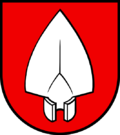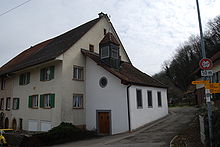Mellikon
| Mellikon | |
|---|---|
| State : |
|
| Canton : |
|
| District : | Zurzach |
| BFS no. : | 4314 |
| Postal code : | 5465 |
| Coordinates : | 668 751 / 268820 |
| Height : | 358 m above sea level M. |
| Height range : | 324–557 m above sea level M. |
| Area : | 2.70 km² |
| Residents: | 226 (December 31, 2019) |
| Population density : | 84 inhabitants per km² |
|
Proportion of foreigners : (residents without citizenship ) |
13.8% (December 31, 2019) |
| Website: | www.mellikon.ch |
|
Mellikon |
|
| Location of the municipality | |
Mellikon ( Swiss German : ˈmɛlikχə ) is a municipality in the Swiss canton of Aargau . It belongs to the Zurzach district and is located on the Upper Rhine on the border with Germany .
geography
The village on the northern edge of the Table Jura is around two hundred meters from the southern bank of the Rhine in the narrow river plain. The southern half of the village is enclosed by two steep hills. These are offshoots of the Güggehübuck in the southwest and the Haslibuck in the southeast. The small hamlets Unterberghof ( 460 m above sea level ) and Oberberghof ( 515 m above sea level ) are located on the slope of the Haslibuck . The slope of the Güggehübuck is characterized by a large quarry in which limestone is extracted. The Tägerbach flows into the Rhine at the eastern border of the municipality.
The area of the municipality is 270 hectares , 140 hectares of which are forested and 52 hectares are built over. The highest point is at 556 meters on the Haslibuck, the lowest at 333 meters on the Rhine. Neighboring communities are Küssaberg in the north, Hohentengen in the northeast, Rümikon in the east, Wislikofen in the southeast, Böbikon in the southwest and Rekingen in the west.
history
In the Rheinzelg area , a section of the wall came to light in 1922, indicating the existence of a Roman watchtower. Meliken was first mentioned in a document in 1113. The place name comes from the Old High German Mellinghofun and means "at the farms of the Mello clan". In the Middle Ages there was only one estate of the Benedictine monastery in Zurzach . The monastery itself was converted into a canon monastery in 1279 . A hamlet slowly developed around the estate. Both the Canon Monastery and Mellikon were under the sovereignty of the Diocese of Constance .
The confederates conquered Aargau in 1415 and Mellikon was now part of the Zurzach office of the County of Baden , a common rule . In 1578 a group of farmers demanded a share of the forest and the common land for their own cultivation, and it was not until 1601 that the Canon Monastery responded to the demands. In 1661 Mellikon, which had grown into a small village in the meantime, finally received the status of a municipality. In March 1798 the French took Switzerland and proclaimed the Helvetic Republic . Mellikon came to the short-lived canton of Baden and has belonged to the canton of Aargau since 1803.
The opening of the Winterthur – Koblenz railway by the Swiss Northeast Railway took place on August 1, 1876. However, Mellikon had to share the station with the neighboring municipality of Rümikon , so that it was located far outside between the two villages. The Swiss soda factory founded in 1914 (today Solvay ) built a quarry above the village. In 1975, Holderbank Cement AG (today LafargeHolcim ) started producing cement on the western border of the municipality , but closed the factory again in 1995. In the same year, Mellikon received a train stop located directly at the village center, which replaced the old Rümikon-Mellikon station.
In 2000 Mellikon joined the administrative cooperation “Verwaltung2000”, which handles the administrative tasks of seven communities in the neighborhood. From 2014, the municipality was involved in the “Rheintal +” project, which envisaged the merger of several municipalities to form the municipality of Zurzach . After the municipal assembly on May 23, 2019 approved the merger with 43 to 20 votes (contrary to the recommendation of the municipal council ), the decision was confirmed in a referendum in Bad Zurzach and seven other municipalities on September 8, 2019, but Mellikon refused with 58 to 64 votes. The merger will therefore take place on January 1, 2022 without Mellikon.
Attractions
coat of arms
The blazon of the municipal coat of arms reads: "In red and white ploughshare." The coat of arms was first depicted on the municipal seal from 1872. For a long time it was unclear whether the inside or outside of the ploughshare should be depicted. In 1973 the local council made the inside binding.
population
The population developed as follows:
| year | 1850 | 1900 | 1930 | 1950 | 1960 | 1970 | 1980 | 1990 | 2000 | 2010 |
| Residents | 199 | 143 | 200 | 220 | 207 | 200 | 191 | 247 | 257 | 241 |
On December 31, 2019, 226 people lived in Mellikon, the proportion of foreigners was 13.8%. In the 2015 census, 43.1% described themselves as Roman Catholic and 34.0% as Reformed ; 22.9% were non-denominational or of other faiths. In the 2000 census, 93.0% said their main language was German and 3.1% Portuguese .
Politics and law
The assembly of those entitled to vote, the municipal assembly , exercises legislative power. The executing authority is the five-member municipal council . He is elected by the people in the majority procedure, his term of office is four years. The parish council leads and represents the parish. To this end, it implements the resolutions of the municipal assembly and the tasks assigned to it by the canton. The Zurzach District Court is the first instance responsible for legal disputes . Mellikon belongs to the XVII (Zurzach) judges' circle.
economy
According to the company structure statistics (STATENT) collected in 2015, there are around 110 jobs in Mellikon, 13% of them in agriculture, 47% in industry and 40% in the service sector. Numerous workers are commuters and work in Bad Zurzach and the surrounding area. Numerous small businesses have settled on the site of the cement factory, which was closed in 1995. The quarry used to serve as a raw material supplier for the production of soda in Bad Zurzach; today limestone blocks are carved out of the rock there, which are used in the construction industry.
traffic
The main road 7 between Basel and Winterthur leads north to Mellikon over, so that the center of the village is not affected by through traffic. The connection to the public transport network is via a stop on the SBB railway line Koblenz – Bülach – Winterthur . The extreme north-east of the municipality is also served by the Baden - Kaiserstuhl post bus line.
education
The community no longer has a school. The kindergarten and primary school (1st and 2nd grade) can be attended in Wislikofen , the 3rd to 6th primary school grade in Rekingen and all upper levels ( Realschule , Secondary School and District School ) in Bad Zurzach . The closest grammar schools are the Baden Cantonal School and the Wettingen Cantonal School .
Web links
- Official website of the municipality of Mellikon
- Administration2000 (administrative cooperation)
- Christoph Herzig: Mellikon. In: Historical Lexicon of Switzerland .
Individual evidence
- ↑ Cantonal population statistics 2019. Department of Finance and Resources, Statistics Aargau, March 30, 2020, accessed on April 2, 2019 .
- ↑ Cantonal population statistics 2019. Department of Finance and Resources, Statistics Aargau, March 30, 2020, accessed on April 2, 2019 .
- ↑ a b Beat Zehnder: The community names of the canton of Aargau . In: Historical Society of the Canton of Aargau (Ed.): Argovia . tape 100 . Verlag Sauerländer, Aarau 1991, ISBN 3-7941-3122-3 , p. 267 .
- ^ National map of Switzerland, sheet 1050, Swisstopo.
- ↑ Standard area statistics - municipalities according to 4 main areas. Federal Statistical Office , November 26, 2018, accessed on June 17, 2019 .
- ^ Martin Hartmann, Hans Weber: The Romans in Aargau . Verlag Sauerländer, Aarau 1985, ISBN 3-7941-2539-8 , p. 182 .
- ↑ About us. Verwaltung2000, accessed June 17, 2019 .
- ^ Philipp Zimmermann, Andreas Fretz, David Rutschmann: Grossfusion im Zurzibiet: 9 municipalities say yes to «Zurzach» - Fisibach refuses to join. Aargauer Zeitung , May 24, 2019, accessed on June 17, 2019 .
- ↑ Pirmin Kramer, Daniel Weissenbrunnen: Zurzibieter large merger is perfect! Eight municipalities say yes, only Mellikon refuses. Aargauer Zeitung , September 8, 2019, accessed on September 10, 2019 .
- ^ Joseph Galliker, Marcel Giger: Municipal coat of arms of the Canton of Aargau . Lehrmittelverlag des Kantons Aargau, book 2004, ISBN 3-906738-07-8 , p. 210 .
- ↑ Population development in the municipalities of the Canton of Aargau since 1850. (Excel) In: Eidg. Volkszählung 2000. Statistics Aargau, 2001, archived from the original on October 8, 2018 ; accessed on June 17, 2019 .
- ↑ Resident population by religious affiliation, 2015. (Excel) In: Population and Households, Community Tables 2015. Statistics Aargau, accessed on June 17, 2019 .
- ↑ Swiss Federal Census 2000: Economic resident population by main language as well as by districts and municipalities. (Excel) Statistics Aargau, archived from the original on August 12, 2018 ; accessed on June 17, 2019 .
- ↑ circles of justice of the peace. Canton of Aargau, accessed on June 17, 2019 .
- ↑ Statistics of the corporate structure (STATENT). (Excel, 157 kB) Statistics Aargau, 2016, accessed on June 17, 2019 .






